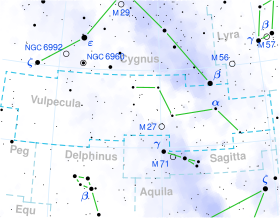| Observation data Epoch J2000 Equinox J2000 | |
|---|---|
| Constellation | Vulpecula |
| Right ascension | 20h 01m 06.0486s[1] |
| Declination | +27° 45′ 12.863″[1] |
| Apparent magnitude (V) | 4.66[2] (4.62 - 4.67)[3] |
| Characteristics | |
| Spectral type | A4IIIm[3] or kA5hA7mA7 (IV–V)[4] |
| U−B color index | +0.15[5] |
| B−V color index | +0.18[5] |
| Variable type | α2 CVn[3] |
| Astrometry | |
| Radial velocity (Rv) | −26.10[6] km/s |
| Proper motion (μ) | RA: 57.817±0.081[1] mas/yr Dec.: 3.994±0.085[1] mas/yr |
| Parallax (π) | 13.4427 ± 0.1050 mas[1] |
| Distance | 243 ± 2 ly (74.4 ± 0.6 pc) |
| Absolute magnitude (MV) | 0.36[2] |
| Details | |
| Luminosity | 59.76[2] L☉ |
| Surface gravity (log g) | 3.45[4] cgs |
| Temperature | 8,084[7] K |
| Metallicity [Fe/H] | +0.02[2] dex |
| Rotational velocity (v sin i) | 15.0[8] km/s |
| Other designations | |
| Database references | |
| SIMBAD | data |
15 Vulpeculae is a variable star in the northern constellation of Vulpecula, located approximately 243 light years away based on parallax.[1] It has the variable star designation NT Vulpeculae; 15 Vulpeculae is the Flamsteed designation. It is visible to the naked eye as a faint, white-hued star with a typical apparent visual magnitude of 4.66.[2] This object is moving closer to the Earth with a heliocentric radial velocity of −26 km/s.[6]

This is an Am star with a stellar classification of A4 IIIm,[3] matching an evolved A-type giant star. However, Gray & Garrison (1989) found a class of kA5hA7mA7 (IV–V),[4] which matches a blend of subgiant and main sequence luminosity classes with the K-line (kA5) of an A5 star and the hydrogen (hA7) and metal (mA7) absorption lines of an A7 star. It is an Alpha2 Canum Venaticorum-type variable with magnitude ranging from 4.62 down to 4.67 over a period of 14 days.[3] The star is radiating 60[2] times the Sun's luminosity from its photosphere at an effective temperature of 8,084 K.[7]
- ^ a b c d e f Cite error: The named reference
Gaia EDR3was invoked but never defined (see the help page). - ^ a b c d e f Anderson, E.; Francis, Ch. (2012). "XHIP: An extended hipparcos compilation". Astronomy Letters. 38 (5): 331. arXiv:1108.4971. Bibcode:2012AstL...38..331A. doi:10.1134/S1063773712050015. S2CID 119257644. Vizier catalog entry
- ^ a b c d e Samus, N. N.; Durlevich, O. V.; et al. (2009). "VizieR Online Data Catalog: General Catalogue of Variable Stars (Samus+ 2007-2013)". VizieR On-line Data Catalog: B/GCVS. Originally Published in: 2009yCat....102025S. 1. Bibcode:2009yCat....102025S.
- ^ a b c Çay, İpek H.; Teker Yelkenci, Aysegul; Adelman, Saul J. (May 2016). "Elemental Abundance Analyses with DAO Spectrograms. XXXIX. The Am Stars 2 UMa and 15 Vul". Publications of the Astronomical Society of the Pacific. 128 (963): 054201. Bibcode:2016PASP..128e4201C. doi:10.1088/1538-3873/128/963/054201. S2CID 123542297.
- ^ a b Mermilliod, J. C. (2006). "VizieR Online Data Catalog: Homogeneous Means in the UBV System (Mermilliod 1991)". VizieR On-line Data Catalog: II/168. Originally Published in: Institut d'Astronomie. 2168. Bibcode:2006yCat.2168....0M.Vizier catalog entry
- ^ a b Gontcharov, G. A. (2006). "Pulkovo Compilation of Radial Velocities for 35 495 Hipparcos stars in a common system". Astronomy Letters. 32 (11): 759–771. arXiv:1606.08053. Bibcode:2006AstL...32..759G. doi:10.1134/S1063773706110065. S2CID 119231169.
- ^ a b McDonald, I.; Zijlstra, A. A.; Boyer, M. L. (2012). "Fundamental parameters and infrared excesses of Hipparcos stars". Monthly Notices of the Royal Astronomical Society. 427 (1): 343–357. arXiv:1208.2037. Bibcode:2012MNRAS.427..343M. doi:10.1111/j.1365-2966.2012.21873.x. S2CID 118665352. Vizier catalog entry
- ^ Glebocki, R.; Gnacinski, P. (2005). "VizieR Online Data Catalog: Catalog of Stellar Rotational Velocities (Glebocki+ 2005)". VizieR On-line Data Catalog: III/244. Originally Published in: 2005csss...13..571G; 2005yCat.3244....0G. 3244. Bibcode:2005yCat.3244....0G. Vizier catalog entry
- ^ "15 Vul". SIMBAD. Centre de données astronomiques de Strasbourg. Retrieved 2018-03-15.
- ^ Cite error: The named reference
Kuvshinovwas invoked but never defined (see the help page).
